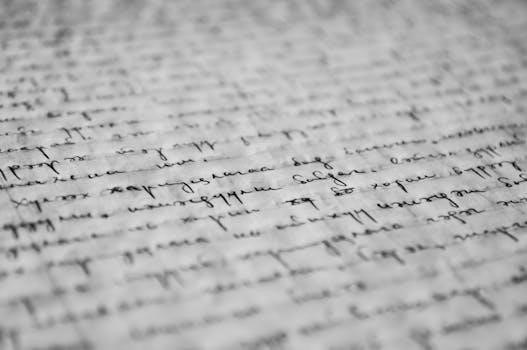
Improving your handwriting is a journey that’s achievable with dedication and the right approach. It’s not just about aesthetics‚ but also about legibility and personal expression. Whether you’re a student or an adult‚ you can enhance your handwriting through deliberate practice and focused attention. This guide will provide tips to elevate your penmanship.
The Importance of Legible Handwriting
Legible handwriting is crucial for effective communication and comprehension. When your handwriting is clear and easily readable‚ it ensures that your thoughts and ideas are accurately conveyed without causing confusion or misinterpretation. In academic settings‚ legible handwriting is essential for teachers to assess students’ work correctly. Poor handwriting can lead to lower grades‚ not due to a lack of knowledge‚ but due to difficulty in understanding the written text. In professional environments‚ clear handwriting is vital for taking notes‚ filling out forms‚ and creating documents that are easily understood by colleagues and clients alike. Furthermore‚ in everyday life‚ legible handwriting makes it easier to communicate with others through handwritten notes‚ cards‚ and letters. It fosters a sense of clarity and respect in communication‚ ensuring that your message is received as intended. The ability to write legibly is a valuable skill that enhances both your personal and professional interactions. Additionally‚ good handwriting fosters confidence and can make the writing process more enjoyable. So‚ investing time to improve the legibility of your handwriting is beneficial for both yourself and those who read your writing.

Fundamentals of Good Handwriting
Good handwriting is built upon a foundation of proper technique and consistency. These fundamentals include maintaining correct posture‚ adopting a comfortable grip‚ and ensuring even letter size and spacing. Mastering these basics is key for improvement.
Proper Posture and Grip
Achieving optimal handwriting starts with a comfortable and correct posture. Sit upright with your feet flat on the floor to ensure a stable base; This allows your hands to be properly positioned on the table‚ promoting steadier and more controlled movements. Avoid slouching‚ as this can restrict your arm and hand movement‚ leading to cramped writing. Your shoulders should be relaxed‚ not tense. The ideal grip on your writing instrument is also crucial. Hold the pen or pencil lightly‚ avoiding a tight grasp that can cause fatigue and reduce fluidity. Experiment with different angles to find what feels most comfortable and allows for smooth strokes. Remember that the correct pen hold can vary between individuals‚ so find what works best for you. A relaxed grip allows for better control and reduces strain‚ leading to improved handwriting quality and consistency. Maintain this posture and grip throughout your practice sessions.
Consistent Letter Size and Spacing
Maintaining consistent letter size and spacing is fundamental to achieving neat and legible handwriting. Uniformity in letter height contributes significantly to the overall appearance of your writing. Avoid fluctuations in size‚ as this can make your handwriting appear disorganized. Aim for a consistent height for all lowercase letters‚ and another consistent height for uppercase letters. Equally important is the spacing between letters and words. Avoid crowding letters together‚ which can make them difficult to distinguish. Similarly‚ do not space letters too far apart‚ as this can break the flow of your writing. Strive for even spacing within and between words. Think of spacing as creating a rhythm for your writing. Practice writing common words and phrases‚ paying close attention to the space between the individual letters. This practice will help reinforce the muscle memory needed to create an even‚ balanced look. Consistent letter size and proper spacing are key elements to achieving handwriting that is both easy to read and visually appealing.

Effective Handwriting Practice
Effective handwriting practice involves more than just writing random letters. Consistent‚ focused effort is needed to improve. This section will focus on how to create a productive practice routine‚ including exercises and tips that will sharpen your skills‚ leading to smoother and more legible writing.
Regular Daily Practice
Consistent daily practice is the cornerstone of handwriting improvement. Just as athletes train regularly to build muscle memory‚ you need to dedicate time each day to hone your writing skills. Aim for at least 15-20 minutes of focused practice‚ setting a specific time to reinforce muscle memory for smoother‚ more legible writing. This regular effort is more effective than sporadic‚ lengthy sessions. Incorporate handwriting into your daily routine by choosing to write notes by hand‚ journaling‚ or doing some calligraphy exercises. By making it a habit‚ you’ll see gradual but significant improvements. Using practice sheets or even writing out paragraphs can keep your handwriting skills sharp. Daily writing will also improve your overall writing fluency and build up the necessary hand muscles for smoother‚ neater results. Remember‚ consistent practice‚ even for short periods‚ is key to long-term success.
Handwriting Drills and Exercises
Handwriting drills and exercises are essential for refining your penmanship; They act as a warm-up for your hand‚ improving precision and consistency. Start with basic strokes like loops‚ circles‚ and straight lines. These exercises help develop the muscle control needed for smooth letter formation. Practice tracing letters and words to train your hand to move in the desired way. Focus on maintaining consistent spacing and letter sizes during these exercises. Experiment with different angles and grips to find what feels most comfortable and natural for you. Use the old-school three-line technique to guide your letter height. Incorporate letter chain practice to refine connections between letters. These drills are like a workout for your hand‚ preparing it for more complex writing tasks. Regular practice with these exercises will help you achieve clear and neat handwriting. Remember‚ these drills are not just about repetition but about focused and deliberate movement.

Advanced Techniques for Improvement
Taking your handwriting to the next level involves exploring different styles and focusing on rhythm and slant. Experimenting will help you find your own unique style. You can also improve by focusing on consistency and adaptability. These techniques enhance both speed and fluency.
Experimenting with Different Styles
There’s no one-size-fits-all approach to handwriting; it’s a deeply personal expression. Don’t feel pressured to mimic someone else’s style. Instead‚ embrace the opportunity to experiment with various techniques until you discover what resonates best with you. Try out different letter forms – some might prefer loopy‚ bubbly letters‚ while others may find angled‚ sharp letters more appealing. Consider the overall height and width of your letters; perhaps you’d prefer narrow‚ tall letters or wider‚ more rounded shapes.
Explore the world of cursive and its variations‚ or delve into the realm of calligraphy for added flair. Remember‚ the goal isn’t to become a copycat‚ but to develop a style that’s both comfortable for you to write and easy for others to read. Experimenting is key to discovering your unique handwriting identity. Challenge yourself by trying different writing utensils and papers‚ which can also influence your writing style. The more you explore‚ the better you’ll understand your preferences and capabilities.
Focusing on Rhythm and Slant
Developing a consistent rhythm and slant is paramount for achieving fluid and aesthetically pleasing handwriting. Rhythm refers to the flow and pace at which you form your letters and words. It’s about creating a sense of harmony in your writing‚ where the letters appear connected and balanced. Practice writing at a steady pace‚ avoiding abrupt stops and starts that can disrupt the overall flow. Think of it as a dance on paper‚ where each movement is purposeful and connected to the next. A consistent slant‚ on the other hand‚ refers to the angle of your letters. Whether you prefer a slight forward tilt or a more upright style‚ maintaining that slant throughout your writing is essential for creating a cohesive look.
Experiment with different slants to find one that feels natural and comfortable for you‚ and then make a conscious effort to stick with it. This consistency in slant and rhythm greatly contributes to the overall neatness and legibility of your handwriting. Don’t rush the process; focus on deliberate and controlled movements to establish these habits.


